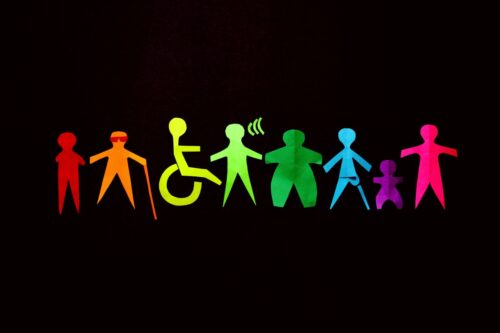Shedding Light on Autism and Why It's An Invisible Disability

While the severity of autism symptoms varies widely, many people with autism do not have obvious physical signs of their disability. Without visible cues, people often do not realize someone has autism. This makes ASD an “invisible disability.”
A sometimes long hidden disability list adds to the misconceptions and mystery for many living with autism. It also blurs the question of is ASD a disability, making it a silent and often overwhelming struggle for many on the spectrum.
Is ASD A Disability? Hidden Disability List for Autism
Unlike physical disabilities that may require a wheelchair, walking aids, or other assistive equipment for mobility and accessibility needs, the challenges those with autism face are largely invisible to outside observers. There are no universally defining physical traits, facial markers, speech attributes or styles of movement that would allow someone unfamiliar with autism to definitively identify it.
Sensory Challenges
Many people with autism have heightened or reduced sensitivities in their five main sensory systems — sight, hearing, taste, touch and smell. For example, loud noises like sirens, large crowds, bright flickering lights, the hum of fluorescent lighting, certain textures of fabrics or foods, even specific smells can be intensely bothersome or painful.
These sensitivities manifest physically through behaviors like covering ears or eyes, odd food preferences, shifting away from being touched, sniffing objects, visual stimulation behaviors like finger fluttering and spinning, and more. However, someone casually observing a person with autism may have no idea that underlying sensory triggers are causing these behaviors.
They only see the behaviors themselves, which seem unexplainable or inappropriate, rather than considering an invisible disability.
Social Skill Deficits
Deficits in social communication and interaction skills are also a core challenge for those with autism. Making eye contact, reading body language and facial expressions, understanding humor, conversing easily with peers, adjusting communication style to the situational context, etc. can be very difficult for people with autism. However, someone unaware of these social skill challenges and invisible characteristics may just view superficial social interactions.
From this limited outside perspective, behaviors can seem odd or inappropriate, when in fact they reflect substantial but invisible neurological differences in how people with autism are wired to take in, interpret and respond to various social cues that neurotypicals inherently understand.
Restrictive/Repetitive Behaviors
Many people with autism need and find comfort in set routines or restrictive interests and behaviors. Needless to say, constantly doing things the same way, obsessing over a specific subject, stacking toys, pacing, getting extremely upset when routines are changed seem unusual to those unaware these behaviors serve a regulatory purpose for someone with autism.
This hidden disability list may just see seemingly odd, quirky behaviors without understanding the deeper reasons behind why someone with autism needs these to cope and self-manage emotions or reactions to overwhelming stimuli.
Sensory Overload
When faced with a lot of challenging sensory input at once – like entering a crowded, noisy store with lots of visual stimulation – it can be intensely overwhelming and distressing, triggering everything from agitation to full blown meltdowns or shutdowns. Outward behaviors as well as invisible characteristics can seem severe for situations neurotypical people would not be deeply bothered by.
However, from the outside people do not experience the onslaught of internal sensory overload. Someone having an autistic meltdown may just look like they are throwing a tantrum or purposefully acting out with no context for invisible overload factor no one else faces to that extreme.
The Invisible Disability Nature of ASD

They do not realize things they brush off easily can be excruciatingly troublesome for someone wired differently. Nor do they have context for outward behaviors that may look inappropriate when they actually reflect someone just trying to cope with sensory, social or other challenges emerging from a hidden disability list of disorders others cannot see.
Drawbacks to Having an Invisible Disability and Confuses the “Is ASD a Disability” Question
This invisible nature of autism poses many problems for those on the spectrum as they navigate a world not built anticipate and accommodate their needs. It also causes difficulty when attempting to answer the “is ASD a disability” question, especially when considering autism’s invisible characteristics.
Judgment from Others
When autism remains invisible to others, outward behaviors arising from the hidden disability often get mistakenly judged. Flapping hands may look silly, covering ears bizarre, monotone speech or limited eye contract rude, public meltdowns like tantrums, special interests like obsessions, and so on.
Without realizing these reflect an underlying disorder, people often form negative assumptions. A person may get viewed as odd, immature, misbehaving, purposefully non-compliant, attention seeking, overly sensitive, etc. when in reality they cannot control behaviors tied to their disability.
This judgment further isolates them, often resulting in masking, and raises doubts on onlookers who naively may wonder, “is ASD a disability” or whether they are just being obnoxious.
Denial of Needed Accommodations
Since people with autism do not have visible markers of disability, it’s easy for others to downplay or deny the challenges they face. For example, sensory sensitivities may get brushed off because noise levels, lighting or other environmental factors do not bother most people.
Without visibly seeing the actual distress loud sounds or textures cause someone with heightened senses, it’s easy to underestimate their needs related to these factors. This means people with autism often struggle to secure basic accommodations that would help them manage their hidden disability list of disorders.
Simple supports like allowing headphones, sunglasses or hats to cope with stimuli, providing written instructions, adjusting communication methods or being more concrete, forgiving social awkwardness or allowing alternative seating/positioning, keeping some routines the same, etc. could be tremendously helpful but often get overlooked or denied because people fail to understand needs arising from an invisible disorder.
Employment Discrimination
Gaining and maintaining employment poses numerous hurdles for people on the autism spectrum, in part because it is a hidden disability. During interviews, social skill challenges, atypical speech patterns and body language, need for accommodations, or difficulties answering questions on the spot can unfairly skew first impressions.
On the job, responses to sensory stimuli, need for structure, social difficulties, poorer executive functioning issues like time management and organization, or inconsistent performance stemming from autism are often invisible characteristics not readily apparent as emerging from an underlying disorder to managers and colleagues.
People often get viewed as odd or deficient workers rather than disabled employees facing extra workplace challenges meriting accommodations and supports. This leads to much higher unemployment rates among autistics. Even when they can secure work, lack of acceptance around their hidden disability list of disorders frequently hinders their career growth and financial earnings potential.
Interpersonal Relationship Barriers of Having An Invisible Disability
Building and sustaining relationships from casual friendships to marriage is also frequently harder for those on the spectrum in part because their disability remains invisible to others. Many autistics want to connect but don’t inherently understand the complex dynamics of relationships, reciprocity, subtext to language and social cues that come naturally to other people.
Without realizing someone has differences in social wiring, people misinterpret their actions (or inaction) as intentional when traits of their hidden disability inadvertently hamper relationship skills. They can get labeled odd, rude, self-centered, emotionally unavailable, inconsiderate, or purposefully hurtful when behaviors actually reflect unspoken disability-related deficits.
These misperceptions sadly isolate many people with autism. Even family members sometimes begin to wonder if some of the invisible characteristics are even real. (Yes, they are.)
Mental Health Impacts
Facing judgment, denial of supports they require, workplace discrimination, loneliness and strained relationships takes immense emotional tolls on people with autism. However, others usually underestimate these psychological impacts of invisible characteristics because they cannot visibly see the distress in someone struggling to cope with both everyday challenges due to autism plus the additional barriers society unfairly puts in their way because their disability remains largely hidden.
This significantly elevates risks for anxiety, depression, low self-worth and even suicidal tendencies. Yet from the outside observers fail to fully grasp how hard seemingly simple things they take for granted are for someone whose neurological wiring makes so many ordinary aspects of life enormously difficult in invisible ways.
Specific Areas Where Increased Awareness is Needed for Invisible Disability
There are many life settings where invisible disability symptoms can impact an autistic’s ability to thrive. They include:
Educational Settings

Social demands to constantly shift groups and settings, make new friends, participate in less structured activities like gym and lunch proves taxing on social-communication skills. Even typical schoolwork can be troublesome if requires filtering background noise, making eye contact, multitasking verbal instructions alongside physical demonstrators, working with peers, etc.
Without adequate teacher and staff training on spotting signs of autism, understanding triggers behind learning or behavioral difficulties, and properly supporting autistic students’ needs, their hidden disability list remains a major roadblock to academic success.
Greater awareness that delays in language, focus issues seeming like ADD/ADHD symptoms, sensory sensitivity-driven behaviors, poor executive functioning difficulties, meltdowns or disengagement stem from an underlying disorder can spur improved responses. Staff should move away from traditional discipline measures or judgment about perceived willful non-compliance when behaviors clearly demonstrate a child’s inability to control challenges arising from autism.
Investing more in training, tools and policies tailored to identifying and responding to hidden disabilities in children and adults pays dividends across educational journeys.
Employment Settings
Many autistic adults struggle to attain living wages, advance in careers, or maintain steady jobs. Even when qualified and skilled, they face discrimination and dismissal due to supervisors misinterpreting their disability as poor performance.
Quieter demeanors get viewed as standoffish instead of social skill deficits. Different behaviors or speech patterns mark someone as odd versus recognizing diversity in expression. Getting overwhelmed by workplace stimuli that seems minor to most people appears like an overreaction unless understood as a real sensory processing difference.
Rigid thinking or difficulty navigating undefined procedures reflects core autistic traits frequently unaccommodated in modern offices centered around nebulous group collaborations.
If autism moved beyond an invisible hurdle to employment and got treated as the bona fide disability requiring workplaces adaptations it is, extra supports could help autistics thrive as productive members of the labor force.
Things like allowing noise cancelling headphones to reduce auditory overload, providing written job instructions, using whiteboards instead of spoken directions for multi-step assignments, granting alternate workspaces, building in verbal processing time during meetings, offering flexibility in hours/locations, explicitly explaining workplace culture norms rather than just expecting intuitive adaptation all enable autistic employees to circumvent everyday workplace challenges.
Small shifts to acknowledge not everyone takes in, manages and expresses information the same way removes stigma around neurological differences. It also conveys that supporting alternative modes fosters innovation from alternative perspectives. Making autism challenges more visible promotes strengths-based approaches to nurturing untapped talents the often gifted autistic mind holds rather than just focusing restrictions needing accommodation.
Community Spaces & Activities
Public areas like stores, transportation hubs, parks, restaurants, theaters and recreational sites rarely get built with accessibility considerations for those with sensory regulation issues in mind. While many venues strive to structurally accommodate physical disabilities, few establish policies, facilities or norms with autistic needs around health, safety and comfort in mind.
Too often public sites strictly regulate any deviations as disruptive exceptions rather than universal design obligations. Only seeing service animals but not therapeutic tools for emotional disabilities like weighted blankets or fidgets denote which disabilities we have space for versus which remain unseen.
Having breakdown rooms for overwhelmed autistic kids could allow many families to engage in more activities if offered sensitive supports in moments of unavoidable meltdowns. Asking all staff to adjust flashing light displays, lower loud music in certain sections, offer noise cancelling headsets, or allow alternative seating demonstrates awareness small segments of customers contend with sensory inputs most barely register.
Just offering compromises, flexibility or assistance without assumption, irritation or automatic threats to remove anyone acting outside “normal” expectations reflects a willingness to welcome all abilities.
Healthcare Settings and Hidden Disability List
Doctors offices, clinics, hospitals and therapy offices need more staff training to identify, diagnose and treat autistic patients with competency, compassion and properly tailored supports adjusting environments suiting their needs. Too often sensory issues, communication variability difficulties articulating issues, or desperation for routine get dismissed or handled punitively causing immense trauma and denial of care access for autistic people.
Clinicians also need greater understanding normalizing biomarkers for development, behavior or physiology versus acknowledging wider healthy diversity especially among disabled groups. Assuming higher anxiety equaling disorder without factoring in reasonable distress of navigating world with disability fuels stigma and dismissal of patients’ rights to care.
Adjusting practices and policies with disability diversity at the fore makes medicine more equitable, inclusive and responsive to all patient populations.
Intimate Relationships
Shortcomings in connections from platonic ties to intimate bonds trace commonly to relational skill gaps tied to autism many partners may not adequately recognize stem from an invisible yet very real disability. Core traits like preference for set routines, strong sensory specificity needs around food textures, scents, clothing materials or sexual touch pose big outliers in expectations for typical sharing, flexibility and reciprocity integral to relationships.
Just struggling reading subtle emotional shifts and nonverbal cues through tone fluctuations or facial expressions risks getting read as emotional neglect when tied to disability versus indifference or malice. Even conflict resolution or expressing affection varies greatly among neurodiverse populations given vast differences interpreting language, navigating change, articulating inner states.
Yet rarely do partners consciously deepen understanding autism itself fuels relational rifts requiring alternate adaptations, compromises or communication styles. All this isolation and frustration could abate by normalizing neurological diversity better within the disguise of normalcy too many cannot see beyond more rigidly defined ableism.
Why Greater Awareness is Needed for Autism Invisible Disability

When people better comprehend why external behaviors reflecting underlying sensory, communication, movement differences and emotional regulation issues emerge in autism, they can extend more empathy, patience and support.
If more individuals recognized the scope of obstacles tied to social skills deficits, executive functioning difficulties, adverse responses to stimuli, need for structure, atypical behaviors meeting legitimate needs, etc., collective perspectives would shift away from judgment toward compassion. Employers, educators, healthcare providers and communities as a whole would hopefully make more efforts to accommodate rather than marginalize those who process, respond and behave somewhat differently due to this intricate, multi-faceted yet poorly understood disorder.
While the severity of challenges facing any given person with autism varies greatly, virtually all on the spectrum wrestle in mostly invisible ways atypical neurological wiring that does not intuitively read social cues, emotional subtleties, filter sensory input, regulate reactions or organize thought. What gets dismissed as quirkiness or difficult behavior actually reflects immense efforts to cope with a disability no one else can see.
But its catastrophic daily impacts on communication, self-regulation, skills development, independence and overall well-being are very real even if hidden behind a guise of normalcy that unfairly camouflages very genuine struggles.
If society grasps how many commonplace things we take for granted pose substantial hurdles for the growing autistic population, ideally greater allowances would get made in public spaces, classrooms, workplaces and communities. Accommodating differences is not coddling limitation but empowering diversity. Understanding autism as an unseen disability enables creating more inclusive environments, systems and social norms for those wired differently.
Because at present we unconsciously erect far too many barriers against marginalized groups when we fail to notice, acknowledge and appreciate experiences outside our own. The simplest yet most transformative initial step we must take is opening our eyes wider to grasp realities facing all people, including those we cannot see on the surface. This holds perhaps especially true for conditions as prevalent yet poorly comprehended as autism in all its boundless complexity.
Answering if ASD A Disability: More Transparency is Needed to Uncloak The Disorder
Autism is a disability but it’s not an obvious one, as you can’t just look at someone and automatically tell they have autism. As an autistic myself, it is clear my diagnosis is more subtle than that.
You may be able to catch a hint or two by talking to someone (like me) but it still won’t be obvious in many cases. Of course, individuals with high support needs may display outward signs that make understanding of differences more apparent. I wish that more people understood these autism adult symptoms.
Having an invisible disability can be both a blessing and a curse, because on one hand, people won’t treat you any differently and you will be treated with equality and respect. However, on the other hand, if you need help dealing with autism, people won’t know if you need help or how to help you because they can’t tell you are autistic and it can be difficult to communicate what exactly you need.
This leads to the question of whether you should disclose your autism to others.
If you found learning about autism being an invisible disability for many on the spectrum, then you might enjoy reading more FAQs related to autism. I’d love to hear from you. Just email me at connor@myautismmind.com
Additional FAQs About Autism Spectrum Disorder
- What Are 25 Common Traits of Autism Spectrum Disorder?
- Think You Know Neurodivergence? Debunking These 25 Popular Myths
- What Are The Top 25 Adult Autism Spectrum Disorder Symptoms?
- Do You Know Your Flavor of Autism Spectrum Disorders?
- Hope for the Future: Will It Transform the Autism World?
- Am I Neurodivergent? Understanding Neurodiversity and Its Value is Key
- Autism Questions: 6 FAQs You Really Want to Know
- Is Autism A Disability? Surprising Reasons for the Debate
- Alexithymia Symptoms: Is Emotional Blindness A Thing?
- Is The Absurd Plot Connecting Autism and Evolution Harmful?